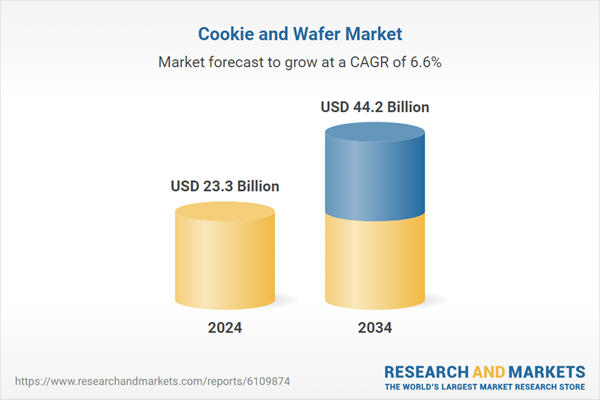Meanwhile, enhancements in packaging formats and broader online and offline distribution networks are expanding reach across various markets. Innovative, consumer-friendly packaging - such as resealable pouches, portion-controlled packs, and eco-friendly materials- is improving product appeal and shelf visibility. At the same time, the growth of omnichannel strategies, including partnerships with major e-commerce platforms, retail chains, specialty health stores, and convenience outlets, is ensuring that products are accessible to a wider audience. These improvements not only support brand visibility but also allow companies to target diverse demographic groups with greater efficiency. By aligning packaging innovation with evolving consumer preferences and leveraging a multi-channel retail footprint, manufacturers can build a stronger market presence and drive repeat purchases in both developed and emerging regions.
In 2024, a chocolate-flavored segment in the cookie and wafer market generated USD 10.5 billion and is forecasted to grow at a CAGR of 6.8% through 2034. Chocolate continues to hold universal appeal with its emotional and indulgent value across all price ranges and demographics. The segment benefits from innovations in chocolate fillings, coatings, and hybrid combinations with milk, dark, and white variants dominating product portfolios globally. The chocolate flavor’s ability to blend seamlessly into both modern and classic snacking preferences sustains its leadership.
The pouches segment captured a 24.2% share in 2024, generating USD 6.2 billion, and is expected to grow at a 6.5% CAGR during 2025-2034. Pouches are favored for their lightweight design, portability, and extended shelf life, making them a top choice for on-the-go snacking. Consumers are increasingly drawn to resealable and stand-up pouch formats that offer convenience, portion control, and easy storage. From a manufacturing standpoint, pouches are not only cost-efficient but also align with sustainability efforts, enhancing their value proposition in the packaging space.
United States Cookie and Wafer Market was valued at USD 5.3 billion in 2024 and is projected to grow at a 6.4% CAGR through 2034. The U.S. remains a key market due to high consumer interest in indulgent snacks and increasing demand for healthier and premium options. Innovation remains at the forefront with leading brands expanding offerings in flavor variety, nutrient-enriched recipes, and size-controlled packs. The presence of a mature retail environment and sophisticated production infrastructure adds further support to sustained market demand. High brand affinity, nostalgia, and evolving consumer preferences continue to fuel widespread adoption among diverse customer segments.
Prominent companies such as Nestle, Parle, Britannia, Mondelez, and Kellogg’s dominate the competitive cookie and wafer market, leveraging extensive portfolios, strong brand equity, and global distribution channels to maintain leadership. Leading players in the cookie and wafer market are focused on expanding their footprint through innovative product development, targeted marketing, and channel diversification. Flavor innovation remains a central strategy, with companies introducing exotic, limited-edition, and health-based variations to cater to changing consumer tastes. Portion-controlled packaging and on-the-go formats are being emphasized to meet demand from busy lifestyles. Major firms are strengthening e-commerce partnerships and direct-to-consumer models to widen digital sales. In parallel, investments in sustainable packaging and clean-label products are helping brands align with consumer values.
Comprehensive Market Analysis and Forecast
- Industry trends, key growth drivers, challenges, future opportunities, and regulatory landscape
- Competitive landscape with Porter’s Five Forces and PESTEL analysis
- Market size, segmentation, and regional forecasts
- In-depth company profiles, business strategies, financial insights, and SWOT analysis
This product will be delivered within 2-4 business days.
Table of Contents
Companies Mentioned
- Archway Cookies
- Arnott's Biscuits Holdings Pty Ltd
- Bahlsen GmbH & Co. KG
- Britannia Industries Limited
- Campbell Soup Company
- Ferrero Group
- General Mills, Inc.
- Grupo Bimbo, S.A.B. de C.V.
- ITC Limited
- Kellogg Company
- Lotus Bakeries
- Meiji Holdings Co., Ltd.
- Mondelez International, Inc.
- Nestlé S.A.
- Parle Products Pvt. Ltd.
- Pepperidge Farm (Campbell Soup Company)
- United Biscuits
- Voortman Cookies Limited
- Walkers Shortbread Ltd.
- Yamazaki Baking Co., Ltd.
Table Information
| Report Attribute | Details |
|---|---|
| No. of Pages | 235 |
| Published | June 2025 |
| Forecast Period | 2024 - 2034 |
| Estimated Market Value ( USD | $ 23.3 Billion |
| Forecasted Market Value ( USD | $ 44.2 Billion |
| Compound Annual Growth Rate | 6.6% |
| Regions Covered | Global |
| No. of Companies Mentioned | 20 |









